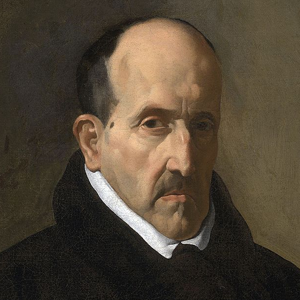Luis de Góngora y Argote (born Luis de Argote y Góngora) (11 July 1561 – 24 May 1627) was a Spanish Baroque lyric poet. Góngora and his lifelong rival, Francisco de Quevedo, are widely considered the most prominent Spanish poets of all time. His style is characterized by what was called culteranismo, also known as Gongorismo. This style existed in stark contrast to Quevedo’s conceptismo.
Góngora was born to a noble family in Córdoba, where his father, Francisco de Argote, was corregidor, or judge. In a Spanish era when purity of Christian lineage (limpieza de sangre) was needed to gain access to education or official appointments, he adopted the surname of his mother, Leonor de Góngora. His uncle, Don Franscisco, a prebendary of Córdoba Cathedral, renounced his post in favor of his nephew, who took deacon’s orders in 1586.
As a canon associated with this Cathedral, he traveled on diverse commissions to Navarre, Andalusia and Castile. The cities that he visited included Madrid, Salamanca, Granada, Jaén, and Toledo. Around 1605, he was ordained priest, and afterwards lived at Valladolid and Madrid.
While his circle of admirers grew, patrons were grudging in their admiration. Ultimately, in 1617 through the influence of the Duke of Lerma, he was appointed honorary chaplain to King Philip III of Spain, but did not enjoy the honor long.
He maintained a long feud with Francisco de Quevedo, who matched him in talent and wit. Both poets composed lots of bitter, satirical pieces attacking one other, with Quevedo criticizing Góngora’s penchant for flattery, his large nose, and his passion for gambling. Quevedo even accused his enemy of sodomy, which was a capital crime in 17th century Spain. In his “Contra el mismo (Góngora)”, Quevedo writes of Góngora: No altar, garito sí; poco cristiano, / mucho tahúr, no clérigo, sí arpía. Góngora’s nose, the subject of Quevedo’s “A una nariz”, begins with the lines: Érase un hombre a una nariz pegado, / érase una nariz superlativa, / érase una nariz sayón y escriba, / érase un peje espada muy barbado.
This angry feud came to a nasty end for Góngora when Quevedo bought the house he lived in for the only purpose of ejecting him from it. In 1626 a severe illness, which seriously impaired the poet’s memory, forced him to return to Córdoba, where he died the next year. By then he was broke from trying to obtain positions and win lawsuits for all his relatives.
An edition of his poems was published almost immediately after his death by Juan López de Vicuña; the frequently reprinted edition by Hozes did not appear until 1633. The collection consists of numerous sonnets, odes, ballads, songs for guitar, and of some larger poems, such as the Soledades and the Fábula de Polifemo y Galatea (Fable of Polyphemus and Galatea) (1612), the two landmark works of the highly refined style called “culteranismo” or “Gongorismo”. Miguel de Cervantes, in his Viaje del Parnaso, catalogued the good and bad poets of his time. He considered Góngora to be one of the good ones.
Velázquez painted his portrait. Numerous documents, lawsuits and satires of his rival Quevedo paint a picture of a man jovial, sociable, and talkative, who loved card-playing and bullfights. His bishop accused him of rarely attending choir, and of praying less than fervently when he did go. Góngora’s passion for card-playing ultimately contributed to his ruin. Frequent allusions and metaphors associated with card-playing in Góngora’s poetry reveal that cards formed part of his daily life. He was often reproached for activities beneath the dignity of a churchman.


10 thoughts on “Kaminos”
Was Nicholas related to Alexander Saslavsky who married Celeste Izolee Todd?
Anyone have a contact email for Yair Klinger or link to score for Ha-Bayta?
wish to have homeland concert video played on the big screen throughout North America.
can organize here in Santa Barbara California.
contacts for this needed and any ideas or suggestions welcomed.
Nat farber is my great grandpa 😊
Are there any movies or photos of max kletter? His wife’s sister was my stepmother, so I’m interested in seeing them and sharing them with his wife’s daughter.
The article says Sheb recorded his last song just 4 days before he died, but does not tell us the name of it. I be curious what it was. I’d like to hear it.
Would anyone happen to know where I can find a copy of the sheet music for a Gil Aldema Choral (SATB) arrangement for Naomi Shemer’s “Sheleg Al Iri”. (Snow on my Village)?
Joseph Smith
Kol Ram Community Choir, NYC
שלום שמעון!
לא שכחתי אותך. עזבתי את ישראל בפברואר 1998 כדי להביא את בני האוטיסט לקבל את העזרה המקצועית שלא הייתה קיימת אז בישראל. זה סיפור מאוד עצוב וטרגי, אבל אני הייתי היחיד עם ביצים שהביא אותו והייתי הורה יחיד בשבילו במשך חמישה חודשים. הוא היה אז בן 9. כעת הוא בן 36 ומתפקד באופן עצמאי. נתתי לו הזדמנות לעתיד נורמלי. בטח, אבות כולם חרא, אומרים הפמינציות, אבל כולם צריכים לעבוד כמטרות במטווחי רובה!
משה קונג
(Maurice King)
Thank you for this wonderful remembrance of Herman Zalis. My late father, Henry Wahrman, was one of his students. Note the correct spelling of his name for future reference. Thank you again for sharing this.
Tirza Wahrman (Mitlak)
amazing zchuso yagein aleinu, he wrote the famous niggun Lefichuch that is sung in almost every Israeli Yeshiva